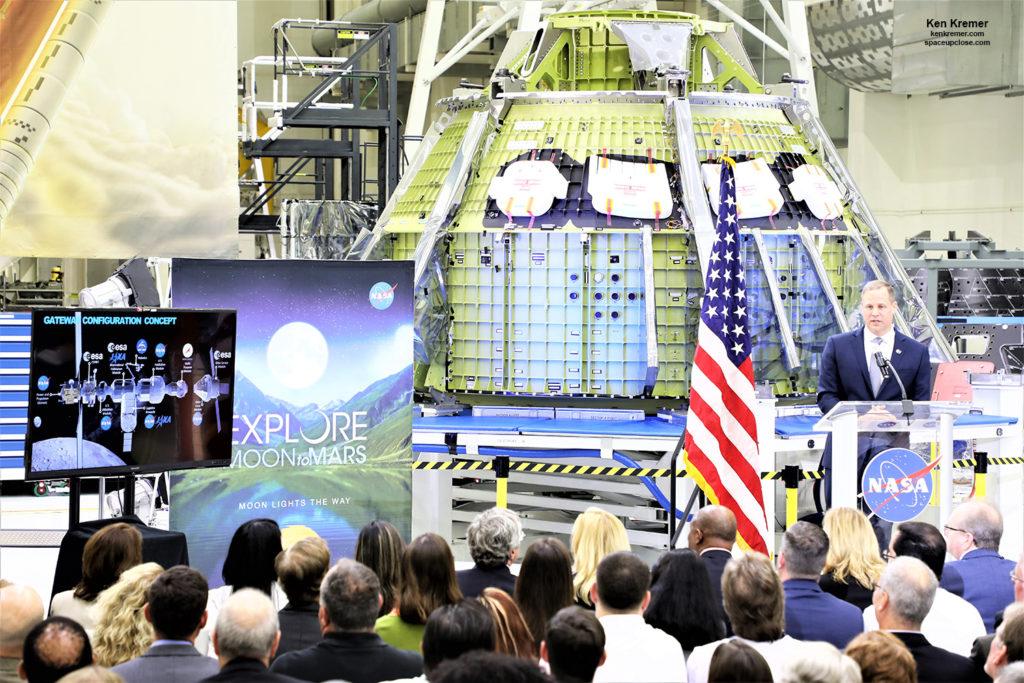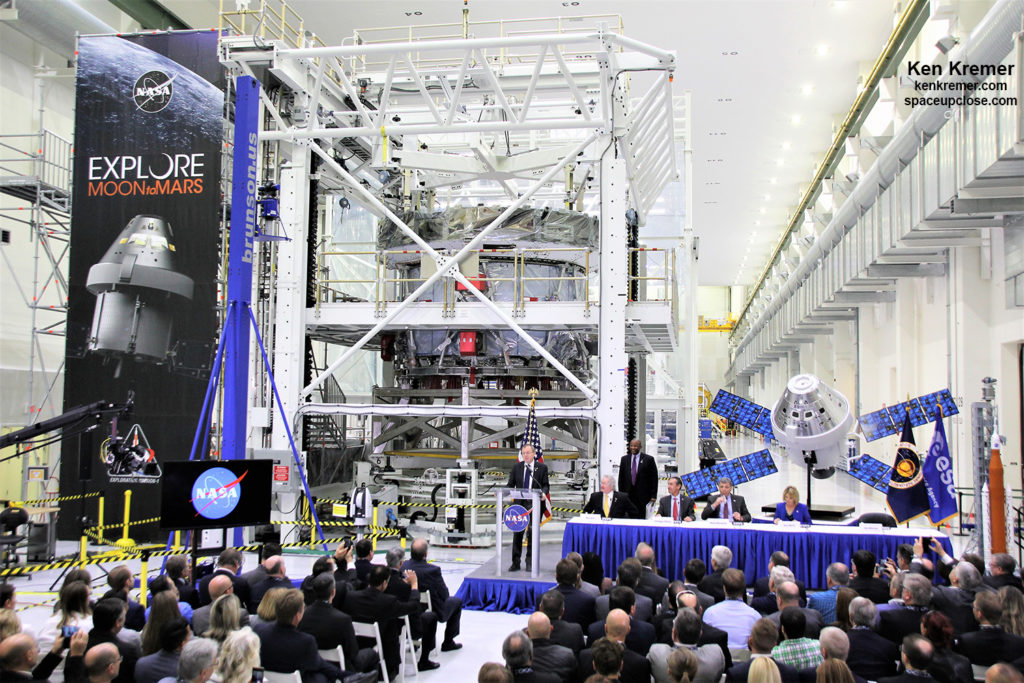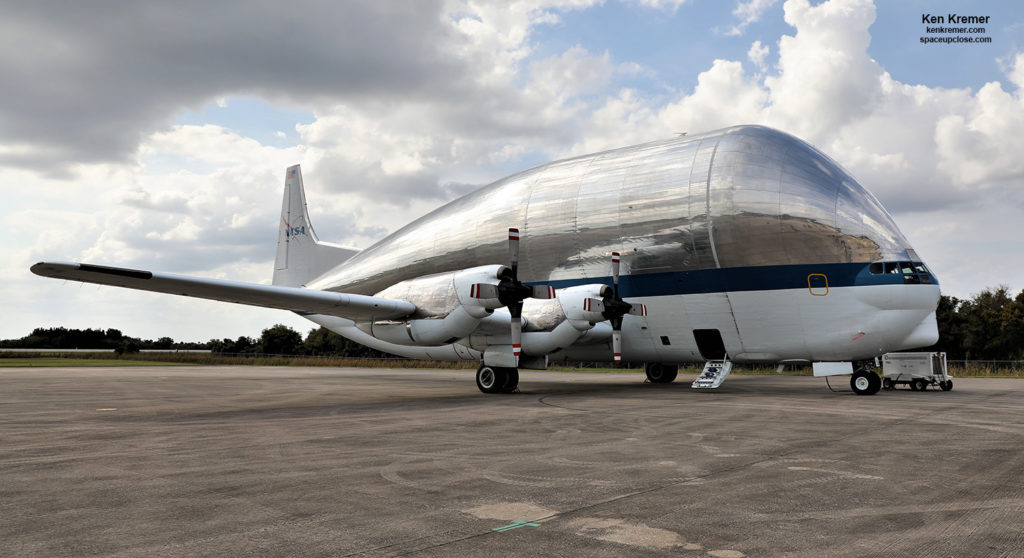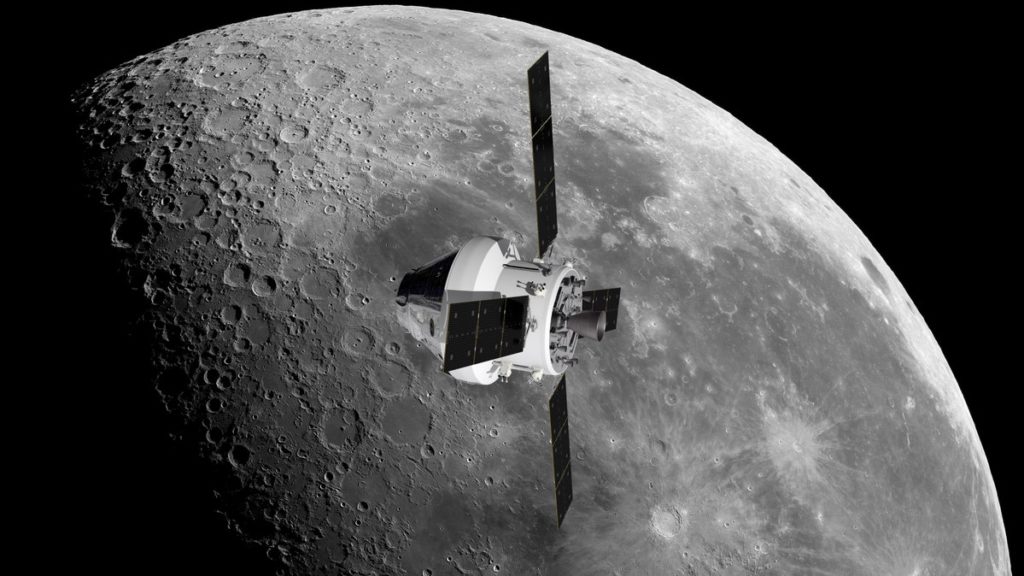 |
|
NASA’s Orion Crew Module and European Service Module
orbit around the Moon. Credit: NASA/ESA, ATG-medialab |
RocketSTEM –13 March 2019
KENNEDY SPACE CENTER, FL – In a startling and totally unexpected turn of
events NASA Administrator Jim Bridenstine said during congressional testimony
today, March 13, that the agency is considering commercial launch vehicle
options for launching Orion’s 1st lunar test flight in mid-2020 as a
last minute alternative to using the mammoth but much delayed Space Launch
System (SLS) megarocket currently under development by the agency.
Orion had been scheduled to launch in June 2020 on its 1st
integrated test flight atop the maiden heavy lift SLS rocket on the uncrewed Exploration
Mission-1 (EM-1) on a three week journey around the Moon and back.
Now, in a shocking twist Bridenstine said NASA is actively
investigating purchasing two heavy lift ‘commercial launch vehicles’ to match
the lifting capability required for an ‘Orion to the Moon’ mission as a replacement
for what would be the first SLS rocket launch – and still accomplish the launch
sometime before the end of 2020, in a race against time to keep the agency on
track for a human return to the Moon for the first time since the last Apollo
Moon landing in 1972.
Replacing SLS so late in the game with two rockets and with
so little time is a gargantuan task- as Bridenstine freely admitted.
Plus a plan on how to split up the Orion Crew components
and the fully fueled upper stage and develop the hardware and software to dock
them in Earth orbit also does not currently exist, Bridenstine admitted.
“Here’s the challenge that we have with EM-1.
SLS is struggling to meet its schedule. It was originally intended to launch in
December of 2019 … no later than June of 2020,” Bridenstine testified to Sen. Roger Wicker (R-Miss.) who chaired
this morning’s open hearing of
the Senate Commerce Committee with the NASA
Administrator in Washington D.C.
“We are now understanding better how difficult this project is,
and that it’s going to take some additional time.”
A decision will come “in
the next couple of weeks. Every moment counts.”
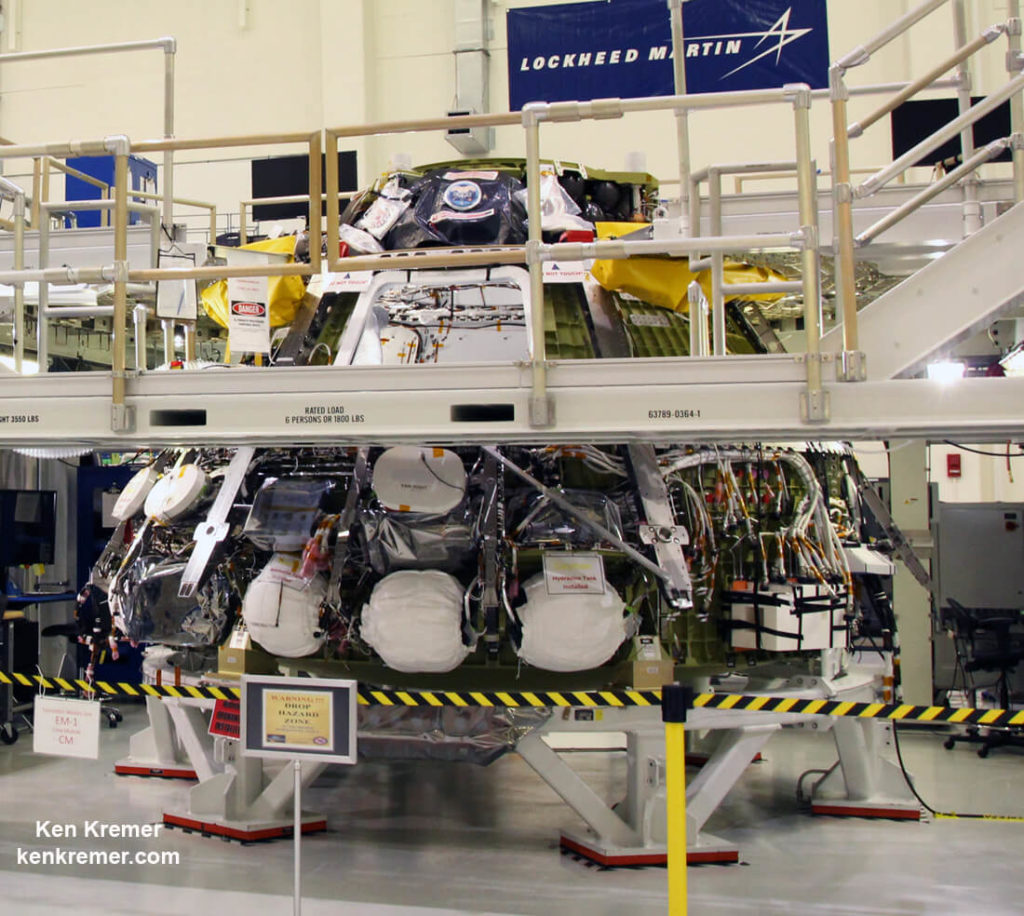 |
|
Orion EM-1 Crew Module under construction at NASA’s Kennedy
Space Center (KSC) in Florida by prime contractor Lockheed Martin. Credit: Ken Kremer/kenkremer.com/spaceupclose.com |
be the most powerful rocket ever built and thus far is the only vehicle with
sufficient thrust and mass lifting capability to propel Orion and its European-built
Service Module to the Moon in one launch augmented by an upper stage.
That was NASA’s baseline plan for SLS-1/Orion EM-1 as outlined
by Jim Bridenstine until just 48 hours ago on Monday March 11, during his NASA 2020
Budget rollout speech at the Kennedy Space Center in Florida – as I witnessed and reported for Space UpClose here.
But just last week NASA informed Congress that the EM-1
test flight would be delayed again due to ongoing problems developing and manufacturing
the gigantic core stage at the heart of SLS – which was of particular concern to Sen. Wicker.
Bridenstine made the stunning remarks about a potential rapid
change in launch vehicle course for Orion at today’s congressional testimony in
response to questioning from Senator Wicker.
“I want to be really clear. I think we, as
an agency, need to stick to our commitments. Sir, if we tell you and others
that we’re going to launch in June of 2020 around the moon, which is what EM-1
is, I think we should launch around the moon June of 2020, and I think it can
be done. We need to consider, as an agency, all options to accomplish that
objective.”
Bridenstine then outlined the alternative to SLS
option further – which is likely to involve private rockets from both SpaceX
and United Launch Alliance (ULA).
The commercial rockets likely would be the
SpaceX Falcon Heavy to launch the combined Orion Crew and Service Modules. The
ULA Delta IV Heavy and Atlas V are candidates to launch the ICPS upper stage required to propel
Orion to the Moon.
Thereafter they have to dock by an as yet unknown method. A new docking adapter would be required.
The ULA Delta IV Heavy commercial
rocket was already used to launch the very first Orion Crew Capsule on the
Exploration Flight Test-1 (EFT-1) mission back in Dec. 2014. But the Delta IV
Heavy rocket is not powerful enough to launch the heavy weight of the Orion Crew
capsule combined with a fully outfitted European Service Module (ESM).
“We need to consider, as an agency, all options
to accomplish that objective. Some of those options would include launching the
Orion crew capsule and the European service module on a commercial rocket,”
Bridenstine elaborated.
“It’s been done before [referring to EFT-1] —
actually not with the European service module — but certainly there are
opportunities to utilize commercial capabilities to put the Orion crew capsule
and the European service module in orbit around the moon by June of 2020, which
was our originally-stated objective, and I’ve tasked the agency to look into
how we might accomplish that objective, so yes, sir, this is a challenge, but I
think we can rise up to meeting it.”
The first European Service Module (ESM) built to power NASA’s
Orion crew spacecraft for human voyages to deep space was unveiled at a welcoming
ceremony held at NASA’s Kennedy Space Center (KSC) in Florida in November 2018 –
see our photos – where it is now being processed for what was planned as the 1st
integrated test flight with the maiden SLS rocket on EM-1 in 2020.
 |
|
Graphic outlining European Service Module for NASA’s Exploration
Mission-1 with Orion human-rated spacecraft and Space Launch System rocket launch to the Moon in 2020. Credit: ESA/Airbus |
Bridenstine’s goal is to keep Orion’s momentum on track
for launch in 2020 while continuing to work out the serious issues now delaying
SLS – and then use the first SLS for the first crewed flight to the Moon with
astronauts on the EM-2 mission scheduled for 2022 or 2023 to get back to NASA’s
currently outlined schedule.
“The key is we want to test fully the Orion crew capsule and the
European service module around the moon, and then ultimately maintain the SLS
program, so that by the time we do EM-2, it will have done a full-up green run
test.”
“By the way, that would be done at the Stennis space center in
Mississippi, Mr. Chairman. and then after the green run test, we will have
tested the SLS, we will have tested the Orion crew capsule and the European
service module around the moon, and then we can get back on track for EM-2. The
goal is to get back on track.”
Wicker noted that this was Bridenstine’s first public mention of
the alternative to launch Orion to the Moon using two commercial rockets in place
of SLS for EM-1.
Wicker then asked – “We’re looking at the possibility of using a
commercial rocket.’ Whose rocket would that be, and how far along are you in
making a decision to go this route in an effort to stick to the mid-2020
schedule?”
a rocket right now that can launch Orion and the European service module around
the moon. That rocket doesn’t exist,” Bridenstine replied.
“That’s what the SLS is all about. Now, here’s what we can do,
potentially — again, we’re starting the process now — we could use two
heavy-lift rockets to put the Orion crew capsule and the European service
module in orbit around the Earth, launch a second heavy-lift rocket to put an
upper stage in orbit around the Earth, and then dock those two together to
throw around the moon the Orion crew capsule with the European service module.”
And therein lies another
hugely significant problem – the ability, hardware and software to dock the two pieces together – Orion and
the upper stage – does not exist at this time!
“I want to be clear. We
do not have, right now, an ability to dock the Orion crew capsule with anything
in orbit. So between now and June of 2020, we would have to make that a
reality.”
Thus time is of the essence and every moment counts.
The money to do all this also doesn’t exist. Congress and
the President will have to step in for any chance to turn this Orion commercial launch
option into reality.
for EM-1, but not change the direction of the SLS and EM-2,” Bridenstine
explained.
“How close are we to being able to make a decision about
whether to do this or not?” Wicker asked.
“What are the expense considerations in making this
decision?”
“I think it can be done, sir, in the next couple of weeks.
Every moment counts. Because, I want to be clear, NASA has a history of not
meeting launch dates, and I’m trying to change that.”
“I think there are options to achieve the objective, but it might
require some help from the Congress.”
“Well, I’d sure like
to keep us on schedule,” said Wicker.
It should be noted that manufacture
of the integrated Orion Crew Module and Service Module stack is nearly ready by
prime contractor Lockheed Martin.
Around July they will be
flown inside NASA’s Super Guppy aircraft to NASA’s Plum Brook facility at NASA Glenn in Ohio for critical vacuum, thermal,
electromagnetic and acoustics testing over several months.
It will be ready for launch
processing after returning to KSC.
Bridenstine’s testimony is whether NASA would launch crew on Orion EM-2 if that
would then become the first SLS launch. NASA has avoided putting astronauts on maiden
launches of new rockets since after the first shuttle flight.
Bridenstine indicated that NASA would still consider astronuats flying on EM-2 –
according to a report in Space News.
Well we live in exciting
times and hopefully NASA can pull this off – but it will only happen if money is
provided.
And the Trump Administration
is not helping matters by calling for a 17% cut in SLS funding and 9% cut to
Orion and deferring work on the SLS Block 1B upgrade with a more powerful upper
stage.
Furthermore President Trumps’ Fiscal Year 2020
NASA Budget request has slashed the agency’s budget by
$480 million or 2.2 % compared to the actual Fiscal Year 2019 budget appropriated
and enacted by Congress in February 2019 – which amounted to $21.5 Billion.
Thus it will be up to President Trump and the US Congress to act
in a bipartisan manner to save NASA exploration and science – that is if they
choose to do so.
Watch for Ken’s continuing
onsite coverage of NASA, SpaceX, ULA, Boeing, Lockheed Martin, Northrop Grumman
and more space and mission reports direct from the Kennedy Space Center, Cape
Canaveral Air Force Station, Florida and Wallops Flight Facility, Virginia.
Stay tuned here for Ken’s continuing Earth and
Planetary science and human spaceflight news: www.kenkremer.com –www.spaceupclose.com – twitter @ken_kremer
– email: ken at kenkremer.com
area, active in outreach and interviewed regularly on TV and radio about space
topics.
Ken’s photos are for sale and he is available for lectures and outreach events
Learn more about the upcoming/recent ULA Delta 4 WGS-10, SpaceX Demo-1, Falcon 9 Nusantara Satu launch, USAF GPS 3-01, SpaceX Falcon 9/CRS-16 launch
to ISS, NASA missions, ULA Atlas &
Delta launches, SpySats and more at Ken’s upcoming outreach events at Quality Inn Kennedy Space Center, Titusville,
FL, evenings:
Mar
14/16: “ULA Delta 4 WGS-10
launch, SpaceX Falcon 9 Demo-1 and Nusantara Satu launch, Dragon CRS-16 resupply launch to ISS, SpaceX
Falcon GPS 3-01, SpaceX Falcon Heavy & Falcon 9 launches, upcoming SpaceX
Falcon 9 USAF GP3 3-01, NRO & USAF Spysats, SLS, Orion, Boeing and SpaceX
Commercial crew capsules, OSIRIS-Rex, Juno at Jupiter, InSight Mars lander, Curiosity
and Opportunity explore Mars, NH at Pluto, Kuiper Belt and more,” Kennedy Space
Center Quality Inn, Titusville, FL, evenings.
Photos for sale
Ken’s
upcoming talks:
Apr 3: “Exploring
Mars; The Search for Life & A Journey in 3-D.” 7 PM, Lawton C
Johnson Middle School, Summit, NJ


